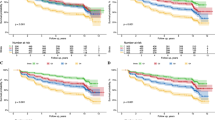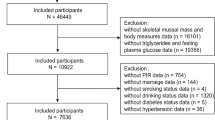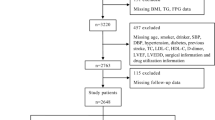Abstract
Background
The triglyceride-glucose (TyG) index performs better at reflecting insulin resistance when combined with waist circumference (WC), body mass index (BMI), and waist-to-height ratio (WHtR) than when used alone. This study aimed to prospectively examine the relationships between TyG, TyG-BMI, TyG-WC, and TyG-WHtR with the incidence of myocardial infarction (MI) and its subtypes.
Methods
This cohort study included 370,390 participants from the UK Biobank. The Cox proportional hazards model and restricted cubic spline regression model were used to assess the associations of TyG, TyG-BMI, TyG-WC, and TyG-WHtR with MI, ST-elevation MI (STEMI) and non-ST-elevation MI (NSTEMI). The receiver operating characteristic (ROC) curve and the area under the curve (AUC) were employed to examine the predictive value of four indicators.
Results
The hazard ratios (HRs) and 95% confidence intervals (CIs) of MI in the highest quartiles for TyG, TyG-BMI, TyG-WC, and TyG-WHtR were 1.36 (1.28–1.44), 1.47 (1.39–1.56), 1.53 (1.43–1.64), and 1.58 (1.48–1.68) in the fully-adjusted model. Comparable findings were observed when the outcomes were reclassified as STEMI or NSTEMI. However, the associations of TyG-BMI, TyG-WC, and TyG-WHtR with the risk of STEMI were weaker than MI and NSTEMI. A linear dose-response association between TyG and the risk of MI and NSTEMI were demonstrated. TyG-BMI, TyG-WC, and TyG-WHtR all showed nonlinear patterns in their associations with the risk of MI, STEMI, and NSTEMI. TyG-WC was most effective in diagnosing MI (AUC: 0.648, 95% CI: 0.644–0.653), STEMI (AUC: 0.631, 95% CI: 0.622–0.639), and NSTEMI (AUC: 0.647, 95% CI: 0.641–0.654).
Conclusion
The TyG index was linearly associated with increased risk of MI and NSTEMI, whereas TyG-BMI, TyG-WC, and TyG-WHtR were nonlinearly associated with increased risk of MI and NSTEMI. There were distinct patterns in the relationships between these indicators with STEMI. TyG-WC provided the best diagnostic effectiveness for MI, STEMI, and NSTEMI.
This is a preview of subscription content, access via your institution
Access options
Subscribe to this journal
Receive 12 print issues and online access
$259.00 per year
only $21.58 per issue
Buy this article
- Purchase on SpringerLink
- Instant access to full article PDF
Prices may be subject to local taxes which are calculated during checkout



Similar content being viewed by others
Data availability
The UK Biobank data are available on application through approval and oversight by the UK Biobank for reasonable requests.
References
Roth GA, Mensah GA, Johnson CO, Addolorato G, Ammirati E, Baddour LM, et al. Global burden of cardiovascular diseases and risk factors, 1990–2019: update from the GBD 2019 study. J Am Coll Cardiol. 2020;76:2982–3021.
Weintraub WS, Daniels SR, Burke LE, Franklin BA, Goff DJ, Hayman LL, et al. Value of primordial and primary prevention for cardiovascular disease: a policy statement from the American Heart Association. Circulation. 2011;124:967–90.
Simental-Mendía LE, Rodríguez-Morán M, Guerrero-Romero F. The product of fasting glucose and triglycerides as surrogate for identifying insulin resistance in apparently healthy subjects. Metab Syndr Relat Disord. 2008;6:299–304.
Tao LC, Xu JN, Wang TT, Hua F, Li JJ. Triglyceride-glucose index as a marker in cardiovascular diseases: landscape and limitations. Cardiovasc Diabetol. 2022;21:68.
Hill MA, Yang Y, Zhang L, Sun Z, Jia G, Parrish AR, et al. Insulin resistance, cardiovascular stiffening and cardiovascular disease. Metabolism. 2021;119:154766.
Lee SH, Kwon HS, Park YM, Ha HS, Jeong SH, Yang HK, et al. Predicting the development of diabetes using the product of triglycerides and glucose: the Chungju Metabolic Disease Cohort (CMC) study. Plos ONE. 2014;9:e90430.
Sánchez-Íñigo L, Navarro-González D, Fernández-Montero A, Pastrana-Delgado J, Martínez JA. The TyG index may predict the development of cardiovascular events. Eur J Clin Invest. 2016;46:189–97.
Hong S, Han K, Park CY. The triglyceride glucose index is a simple and low-cost marker associated with atherosclerotic cardiovascular disease: a population-based study. BMC Med. 2020;18:361.
Tian X, Zuo Y, Chen S, Liu Q, Tao B, Wu S, et al. Triglyceride-glucose index is associated with the risk of myocardial infarction: an 11-year prospective study in the Kailuan cohort. Cardiovasc Diabetol. 2021;20:19.
Lopez-Jaramillo P, Gomez-Arbelaez D, Martinez-Bello D, Abat M, Alhabib KF, Avezum Á, et al. Association of the triglyceride glucose index as a measure of insulin resistance with mortality and cardiovascular disease in populations from five continents (PURE study): a prospective cohort study. Lancet Healthy Longev. 2023;4:e23–e33.
Rafiee H, Mohammadifard N, Nouri F, Alavi TG, Najafian J, Sadeghi M, et al. Association of triglyceride glucose index with cardiovascular events: insights from the Isfahan Cohort Study (ICS). Eur J Med Res. 2024;29:135.
Lim J, Kim J, Koo SH, Kwon GC. Comparison of triglyceride glucose index, and related parameters to predict insulin resistance in Korean adults: an analysis of the 2007-2010 Korean National Health and Nutrition Examination Survey. PLoS ONE. 2019;14:e212963.
Yan S, Wang D, Jia Y. Comparison of insulin resistance-associated parameters in US adults: a cross-sectional study. Hormones (Athens). 2023;22:331–41.
Hu J, Cai X, Li N, Zhu Q, Wen W, Hong J, et al. Association between triglyceride glucose index-waist circumference and risk of first myocardial infarction in Chinese hypertensive patients with obstructive sleep apnoea: an observational cohort study. Nat Sci Sleep. 2022;14:969–80.
Dang K, Wang X, Hu J, Zhang Y, Cheng L, Qi X, et al. The association between triglyceride-glucose index and its combination with obesity indicators and cardiovascular disease: NHANES 2003–2018. Cardiovasc Diabetol. 2024;23:8.
Sudlow C, Gallacher J, Allen N, Beral V, Burton P, Danesh J, et al. UK biobank: an open access resource for identifying the causes of a wide range of complex diseases of middle and old age. Plos Med. 2015;12:e1001779.
Head A, Birkett M, Fleming K, Kypridemos C, O’Flaherty M. Socioeconomic inequalities in accumulation of multimorbidity in England from 2019 to 2049: a microsimulation projection study. Lancet Public Health. 2024;9:e231–e239.
Pazoki R, Dehghan A, Evangelou E, Warren H, Gao H, Caulfield M, et al. Genetic predisposition to high blood pressure and lifestyle factors: associations with midlife blood pressure levels and cardiovascular events. Circulation. 2018;137:653–61.
Li FR, Wu KY, Fan WD, Chen GC, Tian H, Wu XB. Long-term exposure to air pollution and risk of incident inflammatory bowel disease among middle and old aged adults. Ecotoxicol Environ Saf. 2022;242:113835.
Ma H, Li X, Sun D, Zhou T, Ley SH, Gustat J, et al. Association of habitual glucosamine use with risk of cardiovascular disease: prospective study in UK Biobank. BMJ. 2019;365:l1628.
Ortega LS, Bradbury KE, Cross AJ, Morris JS, Gunter MJ, Murphy N. A prospective investigation of body size, body fat composition and colorectal cancer risk in the UK biobank. Sci Rep. 2017;7:17807.
Elliott P, Peakman TC. The UK Biobank sample handling and storage protocol for the collection, processing and archiving of human blood and urine. Int J Epidemiol. 2008;37:234–44.
Young KG, McGovern AP, Barroso I, Hattersley AT, Jones AG, Shields BM, et al. The impact of population-level HbA(1c) screening on reducing diabetes diagnostic delay in middle-aged adults: a UK Biobank analysis. Diabetologia. 2023;66:300–9.
Cepeda-Valery B, Slipczuk L, Figueredo VM, Pressman GS, Morris DL, Lavie CJ, et al. Association between obesity and infarct size: insight into the obesity paradox. Int J Cardiol. 2013;167:604–6.
Ormazabal V, Nair S, Elfeky O, Aguayo C, Salomon C, Zuñiga FA. Association between insulin resistance and the development of cardiovascular disease. Cardiovasc Diabetol. 2018;17:122.
Bornfeldt KE, Tabas I. Insulin resistance, hyperglycemia, and atherosclerosis. Cell Metab. 2011;14:575–85.
Laakso M, Kuusisto J. Insulin resistance and hyperglycaemia in cardiovascular disease development. Nat Rev Endocrinol. 2014;10:293–302.
Chen W, Wang S, Lv W, Pan Y. Causal associations of insulin resistance with coronary artery disease and ischemic stroke: a Mendelian randomization analysis. BMJ Open Diabetes Res Care. 2020;8:e001217.
Acknowledgements
We are grateful to the UK Biobank participants. This study was carried out with the UK Biobank Resource under project 129048.
Funding
This work was supported by Sichuan Science and Technology Program (No. 24ZDYF0994) and Sichuan Cadre Health Research Project (No. Chuanganyan 2021-203).
Author information
Authors and Affiliations
Contributions
JZ, Hui Huang, and LZ analyzed the data and wrote the first draft of the manuscript. Hao Huang, JP, WC, FC, YT, and QL interpreted the data and revised the manuscript. LZ, and YX designed the study and carefully revised the manuscript. All authors read and approved the final manuscript.
Corresponding authors
Ethics declarations
Competing interests
Dr Long Zhou’s work has been funded by Sichuan Science and Technology Program. Dr Li’s work has been funded by Sichuan Cadre Health Research Project. The funding sources had no role in the design of the study, collection and analysis of data or decision to publish. The other authors declare no potential competing interests.
Ethics approval and consent to participate
Full ethical approval for the UK Biobank study was obtained from the North West Multi-center Research Ethics Committee (MREC) (Reference: 21/NW/0157). All procedures performed in studies involving human participants were in accordance with the 1964 Helsinki Declaration and its later amendments. Informed consent was obtained from all participants.
Additional information
Publisher’s note Springer Nature remains neutral with regard to jurisdictional claims in published maps and institutional affiliations.
Supplementary information
Rights and permissions
Springer Nature or its licensor (e.g. a society or other partner) holds exclusive rights to this article under a publishing agreement with the author(s) or other rightsholder(s); author self-archiving of the accepted manuscript version of this article is solely governed by the terms of such publishing agreement and applicable law.
About this article
Cite this article
Zhou, J., Huang, H., Huang, H. et al. Association of triglyceride-glucose index and its combination with adiposity-related indices with the incidence of myocardial infarction: a cohort study from the UK Biobank. Int J Obes 48, 1498–1505 (2024). https://doi.org/10.1038/s41366-024-01612-5
Received:
Revised:
Accepted:
Published:
Issue date:
DOI: https://doi.org/10.1038/s41366-024-01612-5



